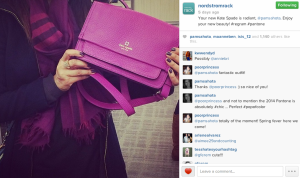
According to Twitter’s blog – “last year, people on Twitter shared over 100 million GIFs…”- no big deal right? Perhaps that’s why Twitter has also allowed brands and consumers to discover, consume, and share GIFs even more easily through GIF search on Twitter. And if that’s not enough you can search more on tumblr. And even dating apps like Bumble allow you to respond via GIF. It’s a whole new world…
Have the GIFs taken over? Are emojis in trouble? Game of the “Animated Content” to show us who will take the Throne?
So what does that mean for brands?
Brands should consider how GIFs can play into their content strategy, especially within social media and blogs. GIFs are shareable content and allow consumers to relate and get a feeling or emotion a lot faster than reading through a bunch of text. Especially when consumers are going to pass through your content in seconds, through their newsfeed, a GIF can catch their attention. It may have actual stopping power if it’s engaging and creative enough (fun, funny, and relatable). And stopping power is a hard thing to do, especially when social media is so cluttered, through both paid content and organic. Both curated and original. Both visual and not. GIFs are a way to grab attention, and then your brand has to remember to take it from there, because a GIF can only do so much.
And if your brand is unsure, there are other visual animations that you can consider. For example, emojis are still at play. Some brands use them in subjects line in email marketing in order to get a consumer’s attention in their inbox. We all know the inbox is a mind field of clutter, and getting a consumer to get past the subject line and preview, to actually open the email is no small feat. Others use emojis in their social media text to represent a certain emotion or feeling, that can be relatable to consumers.
Remember, your brand has to evaluate and consider whether it’s worth curating existing GIFs (or emojis, etc) or creating your own. The key here again is relevance to the consumer. GIFs alone don’t mean anything, but within context and surrounded by key messaging related to the brand, they can provide an opportunity to engage with the user on a different level. For example, consumers enjoy content that allows them to share it with their own friends and audience. If your content can get to that level, then you’ve reached true engagement with your consumer. Because nowadays it’s not about the eyeballs you get on your GIF (and content), it’s about the action the consumer takes when they see it. Will they like it (ok, cool), will they share it (better), will they comment positively (also, cool), and/or will they start following your brand to get more content (even better).
Still unsure? Just look at the new Apple iOS for the iPhone. It allows consumers to share GIFs built into their keyboard. In addition, consumers have had the ability to add and use different emoji keyboards, as well as create their own Bitmoji to communicate with. There are some consumers who only communicate through imagery now (hello, Snapchat). This is a white space for brands to enter. Imagine your brand (example Top Shop) having created your own imagery (emojis, gifs) for consumers to have access to and use as part of their communication. It becomes organic use of branded content or related content. Your consumers are now sharing a piece of your brand, a story through their eyes. A whole new form of UGC.
Always do your research and only enter this universe, if GIFs/Emojis are relevant to your brand. It has to be authentic to work well. For example is the brand voice/tone humorous, entertaining and/or human. We hope so (at least with the third). If so, your brand can find GIFs that are able to be shared within the brand tone, without going against the grain of the brand. For example, an athletic brand could find humor in training, and/or provide a quick tip on how to do something. A financial brand, could find irony in finances, that allow consumers to relate. While a fashion brand could find something fun and entertaining to share. Something that consumers are like, wow that’s cool – I must share this now.
In the end, GIFs are here people. Embrace them at your own risk (i.e. at your own fun). And when you’ve had enough, they’ll be something new and shiny around the corner, of course.


